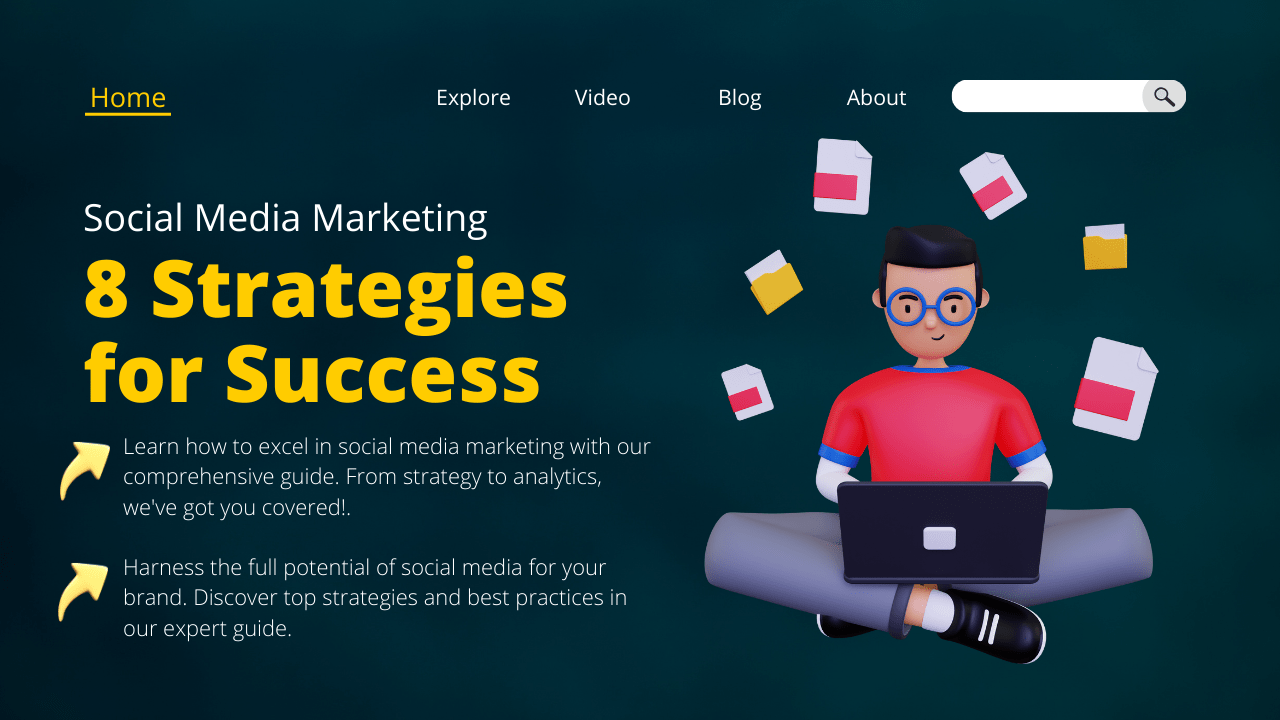5 Social Media Guide to Creating Engaging Content
Social media has become an integral part of our lives. Whether you’re an individual, a small business owner, or a large corporation, the power of social media for communication, marketing, and engagement cannot be overstated. But in a world flooded with content, how do you stand out and create engaging content that captivates your audience? This comprehensive guide will provide you with the insights, strategies, and tips you need to master the art of creating compelling content on social media.
To create engaging content, you must first understand the ever-evolving landscape of social media. From Facebook and Instagram to Twitter and TikTok, each platform has its unique characteristics, demographics, and algorithms. Consider your target audience and choose the platforms that align with your goals.
Understanding the Social Media Landscape
To truly master the art of creating engaging content on social media, it’s essential to develop a comprehensive understanding of the vast and diverse social media landscape. This entails not only recognizing the major platforms but also comprehending their nuances, audience demographics, and the role they play in the digital ecosystem.
The Major Players
- Facebook: With its 2.8 billion monthly active users, Facebook remains the giant of social media. It’s a versatile platform that accommodates various content formats, including text, images, and videos. It’s ideal for building communities, sharing long-form content, and connecting with a broad range of demographics.
- Instagram: Instagram, with 1 billion users, is a visual paradise. Users engage primarily with images and short videos. Features like Stories and IGTV allow for real-time, interactive engagement and long-form video content.
- Twitter or now X: Twitter, boasting 330 million monthly users, is the realm of real-time updates, news, and short, concise interactions. The effective use of hashtags and trending topics can make a significant impact on this platform.
- LinkedIn: With 774 million members, LinkedIn caters to professionals and B2B connections. It’s the go-to platform for career networking, industry-related content, and sharing knowledge through long-form articles.
- TikTok: Emerging as a major player with over 1 billion users, TikTok is all about creative, short videos. It’s particularly popular among younger audiences and serves as a playground for entertainment, challenges, and trends.
- Pinterest: Pinterest’s 450 million users seek inspiration and ideas through visual boards. It’s a treasure trove for content that is visually appealing, tutorial-based, and driven by creativity.
- YouTube: YouTube, with a staggering 2 billion users, reigns as the second-largest search engine globally. It’s the kingdom of video content, making it ideal for tutorials, product reviews, and compelling storytelling through video.
Audience and Content Alignment
Understanding your target audience is fundamental. Tailoring your content to resonate with your specific demographic can make or break your social media strategy. Consider the following aspects:
- Demographic Data: Research and gather demographic data related to the users on each platform. This includes factors like age, gender, location, and interests.
- Content Preferences: Determine the type of content that your target audience engages with the most. For instance, younger users might prefer short, visually stimulating content, while professionals may gravitate towards informative articles or thought leadership pieces.
- Platform Dynamics: Be aware of the unique features and dynamics of each platform. Facebook’s emphasis on community building differs from Twitter’s focus on real-time conversations or Instagram’s visual-centric approach.
The Versatility of Content Formats
To succeed in the realm of social media, you should harness a wide range of content formats. These include:
- Text: Craft compelling captions and informative text-based posts that resonate with your audience.
- Images: Use high-quality visuals that capture attention and tell a story.
- Videos: Short videos, live streams, and longer-form videos can engage different segments of your audience.
- Infographics: Simplify complex information into easily digestible graphics.
- User-Generated Content: Encourage your audience to become content creators themselves. Share user-generated content to build trust and credibility.
Staying Current and Adaptable
In the ever-evolving landscape of social media, staying up-to-date with trends, algorithm changes, and platform updates is crucial. What worked yesterday might not work tomorrow, and what resonates on one platform might fall flat on another. Be open to experimentation and adaptation, and be prepared to fine-tune your strategy as needed.
Understanding the social media landscape is the foundation upon which you can build a successful and engaging content strategy. By recognizing the differences between platforms, aligning your content with your audience’s preferences, and remaining adaptable, you’ll be well-equipped to create compelling content that captivates and converts on social media.

Crafting Captivating Content
Creating content that captivates your audience on social media is both an art and a science. To succeed, you must employ various strategies and techniques that not only grab attention but also encourage engagement, shares, and conversions. Here’s a closer look at how to craft content that truly resonates.
The Power of Storytelling
Storytelling is at the core of captivating content. Human beings have an innate love for stories, and they provide a unique opportunity to create an emotional connection with your audience. Here’s how you can leverage storytelling:
- Emotion and Relatability: Craft stories that evoke emotions and are relatable to your target audience. Share personal anecdotes, customer success stories, or behind-the-scenes glimpses into your brand. These narratives make your content more authentic and relatable.
- Conflict and Resolution: A compelling story often involves a conflict and its resolution. Highlight challenges your customers face and how your product or service helps them overcome these obstacles. This builds anticipation and engagement.
- Visual Storytelling: Visual content like images and videos is a powerful tool for storytelling. Use these mediums to narrate a story, whether it’s showcasing your product in action or illustrating a customer’s journey.
User-Generated Content
Encourage your audience to become content creators themselves. User-generated content (UGC) is a goldmine for captivating content:
- Builds Trust: UGC is seen as more authentic and trustworthy. Highlight customer reviews, testimonials, and user-submitted photos or videos to build trust and credibility.
- Community Building: UGC fosters a sense of community. When your customers create content related to your brand, they become brand advocates, deepening their connection with your business.
- Social Proof: Displaying UGC serves as social proof, showing potential customers that others have had a positive experience with your brand.
Leveraging Trends and Hashtags
Staying on top of trends and using relevant hashtags is a powerful way to create captivating content. Here’s how you can do it effectively:
- Stay Informed: Regularly research and monitor trends within your niche or industry. Use tools and analytics to identify emerging trends and conversations.
- Timely Relevance: Create content that is timely and relevant to current trends and events. Capitalize on trending topics and discussions to increase your content’s visibility.
- Appropriate Hashtags: Use hashtags strategically. They can expand your content’s reach and help it become part of trending conversations. However, ensure the hashtags you use are genuinely related to your content to avoid appearing disingenuous.
- Participate Actively: Engage in trending conversations and discussions. Share your insights and opinions, and be an active participant in the community. This increases your visibility and credibility.

Visual Appeal
Visual content is incredibly captivating on social media. Here’s how you can use visuals effectively:
- High-Quality Imagery: Ensure your images and videos are of high quality. Blurry or unprofessional visuals can deter engagement.
- Consistency: Maintain a consistent visual aesthetic across your content. This helps in creating a strong brand identity and makes your content easily recognizable.
- Infographics: Visuals like infographics are great for presenting information in a clear and visually appealing way. Use them to explain complex concepts or statistics.
- Live Video: Live streaming is a dynamic way to engage with your audience in real-time. It’s often more engaging because viewers can interact with you during the broadcast.
Experimentation and Adaptation
Creating captivating content is an ongoing process. It requires experimentation and adaptation. Some additional tips include:
- Content Calendar: Create a content calendar to plan your posts, but also be open to spontaneous, timely content.
- Engage with Your Audience: Respond to comments and messages promptly. Engaging with your audience fosters a sense of community and trust.
- A/B Testing: Experiment with different types of content, posting times, and strategies. A/B testing allows you to identify what works best for your audience and refine your approach.
Crafting captivating content is a blend of creativity, audience understanding, and adaptability. By mastering the art of storytelling, encouraging user-generated content, leveraging trends, and keeping your visuals engaging, you can create content that not only captures your audience’s attention but also fosters meaningful connections and conversions.

Optimizing for Each Platform
Every social media platform has its unique characteristics, audience, and best practices. To create engaging content, it’s crucial to tailor your approach to the specific platform you’re using. Here’s a detailed look at optimizing content for some of the major platforms:
Instagram: Visual Aesthetics
Instagram is all about visual appeal. To optimize content on this platform:
- Maintain a Consistent Aesthetic: Your Instagram feed should have a cohesive look and feel. Choose a consistent color scheme, filter, and style that aligns with your brand.
- Use Instagram Stories: Stories are a powerful tool for real-time engagement. They allow you to share daily updates, behind-the-scenes content, and quick interactive polls or Q&A sessions.
- Leverage IGTV: IGTV is Instagram’s platform for longer-form video content. Use it for in-depth product demonstrations, tutorials, or storytelling.
- Engage with Hashtags: Incorporate relevant and trending hashtags into your posts. Research popular hashtags in your niche to expand your reach.
Twitter: Bite-Sized Brilliance
Twitter’s character limit may seem limiting, but it’s a platform for concise and impactful content:
- Craft Witty Tweets: Due to the character constraint, wit and brevity are your best allies. Craft tweets that are not only informative but also humorous or thought-provoking.
- Hashtags Are Key: Use relevant hashtags to increase the visibility of your tweets. Incorporate trending hashtags when appropriate to join in on relevant conversations.
- Participate in Trends: Stay updated with trending topics and engage in conversations around them. Sharing your perspective on current events can make your content more relevant and engaging.
Facebook: Community Building
Facebook is ideal for community building and in-depth content. To optimize your content on this platform:
- Create Facebook Groups: Establishing groups related to your niche or brand can foster a sense of community. It’s an excellent place for discussions, sharing valuable content, and building a loyal following.
- Host Live Events: Facebook Live allows you to interact with your audience in real-time. Use it for Q&A sessions, product launches, or behind-the-scenes glimpses.
- Share Valuable Content: In addition to posts, share articles, blog posts, and videos that provide value to your audience. The more informative and valuable your content, the more engagement it will receive.
Measuring Success and Iterating
No matter the platform, measuring your content’s success and adapting your strategy is crucial. Here are some key steps in this process:
- Key Metrics to Monitor: Track essential metrics such as likes, shares, comments, click-through rates, and conversion rates. Each platform provides analytics tools to help you gather data. Tools like Facebook Insights and Google Analytics can also be used for a deeper understanding of your audience’s behavior.
- A/B Testing and Experimentation: Experiment with different types of content, posting times, and strategies. A/B testing allows you to identify what works best for your audience. For example, test different posting times to determine when your audience is most active.
- Audience Insights: Dive into the insights provided by each platform to understand your audience better. You can learn about their demographics, interests, and behaviors. Use this information to refine your content strategy.
- Content Calendar: Create a content calendar that outlines what you’ll post and when. Consistency is crucial for audience engagement. Plan your content to align with your audience’s preferences.
Optimizing content for each platform requires a deep understanding of the platform’s unique features and your audience’s preferences. By crafting content that resonates with the platform’s dynamics and your target audience, you can increase engagement and achieve your social media goals effectively. Remember, flexibility and adaptation are key in the ever-evolving world of social media.

Measuring Success and Iterating
In the world of social media, success is not a one-time achievement but an ongoing process. To create engaging content and continually improve, it’s essential to measure your performance and make data-driven decisions. Here’s a detailed look at how to measure success and iterate effectively:
Key Metrics to Monitor
Measuring success on social media begins with tracking key performance metrics. These metrics provide insights into how your content is performing and how it’s resonating with your audience. Some of the most important metrics to monitor include:
- Likes and Reactions: These metrics reflect the number of people who appreciate your content. They signify engagement and can be an indicator of how well your content is received.
- Shares and Retweets: The number of times your content is shared indicates its virality and reach. High sharing numbers suggest that your content is resonating with your audience.
- Comments and Replies: Comments provide valuable feedback and engagement. The more comments a post receives, the more it’s fostering discussions and connections.
- Click-Through Rates (CTR): This metric shows how many people clicked on a link in your content. It’s crucial for tracking the effectiveness of call-to-action (CTA) buttons or links.
- Conversion Rates: Conversion rates tell you how many people took the desired action after engaging with your content. This action could be signing up for a newsletter, making a purchase, or filling out a contact form.
- Follower Growth: Tracking your follower count over time indicates how successful your content is in attracting and retaining an audience.
- Impressions and Reach: These metrics reveal how many people have seen your content. Impressions represent the number of times your content is displayed, while reach indicates the number of unique viewers.
- Engagement Rate: This is a composite metric that considers likes, shares, comments, and clicks relative to your follower count. It provides an overall view of your content’s engagement level.
A/B Testing and Experimentation
Experimentation is a key element of measuring success and improving your content strategy. Here’s how you can effectively experiment:
- Different Content Types: Try various types of content, such as images, videos, infographics, and text-based posts. Analyze which types generate the most engagement.
- Posting Times: Experiment with different posting times and days to determine when your audience is most active and responsive.
- Content Frequency: Test how often you should post content. Some audiences prefer daily updates, while others may engage more with weekly posts.
- Hashtags: Experiment with different hashtags to determine which ones improve the visibility and reach of your content.
- Content Themes: Assess which content themes or topics resonate the most with your audience. Pay attention to the subject matter that receives the most likes, shares, and comments.
Audience Insights
Understanding your audience is fundamental to measuring success and iterating. The insights you gain into your audience’s demographics, preferences, and behaviors are invaluable for refining your content strategy. Here’s how to leverage audience insights:
- Demographic Data: Know your audience’s age, gender, location, and interests. Tailor your content to align with these demographics.
- Behavioral Insights: Learn when your audience is most active on the platform. Post content at times that coincide with their peak engagement periods.
- Content Preferences: Analyze which types of content your audience engages with the most. Create more of what they like.
- Feedback and Comments: Pay close attention to the comments and feedback your audience provides. Address questions, respond to comments, and use their feedback to adapt your content.
- Competitor Analysis: Study the content strategies of your competitors. Identify what works for them and whether you can incorporate successful elements into your strategy.
Content Calendar
A well-structured content calendar is a vital tool for consistency and planning. Create a calendar that outlines what you’ll post and when. It should align with your audience’s preferences and reflect the results of your experimentation and measurement.
Regular Review and Adaptation
Measuring success on social media is an ongoing process. Regularly review your analytics and adapt your strategy accordingly. What worked in the past may not always work in the future, and audience preferences can change. Stay flexible and be prepared to fine-tune your content strategy to keep it engaging and effective.
By measuring success, conducting A/B testing, leveraging audience insights, and maintaining a well-structured content calendar, you can continually improve your social media content strategy. Remember, it’s a dynamic process, and the ability to adapt and evolve your strategy is key to long-term success on social media.
Conclusion
In the world of social media, creating engaging content is an art and a science. It requires a deep understanding of your audience, a commitment to storytelling, and a willingness to adapt and experiment. Remember, it’s not just about posting; it’s about building meaningful connections with your followers. So, take what you’ve learned here and embark on your journey to crafting content that captivates and converts.
Now, it’s your turn. Start implementing these strategies and watch your social media presence soar. Your engaged audience is just a few captivating posts away!.
Don’t forget to share your success stories and insights with us. We’d love to hear how this guide has transformed your social media game.
Key Takeaways
- Understand Your Audience: Knowing your audience’s preferences, demographics, and behaviors is the foundation of engaging content creation.
- Leverage the Power of Storytelling: Craft stories that resonate with your audience, evoke emotions, and build connections.
- User-Generated Content Builds Trust: Encourage your audience to become content creators themselves. User-generated content fosters trust and authenticity.
- Stay Current with Trends and Hashtags: Keep an eye on trends and use relevant hashtags to increase your content’s visibility.
- Optimize for Each Platform: Tailor your content to the unique characteristics and dynamics of each social media platform.
- Measure Success and Iterate: Regularly track key metrics, experiment with different content strategies, and use audience insights to adapt and improve your content.
FAQs
1. What’s the most important metric to monitor on social media?
The most important metric can vary depending on your goals, but overall engagement rate is crucial. It considers likes, shares, comments, and clicks relative to your follower count, providing an overview of how well your content is performing.
2. How can I encourage user-generated content from my audience?
Encouraging user-generated content involves creating contests, challenges, or campaigns that motivate your audience to create and share content related to your brand. Offering incentives or featuring user content on your profile can also be effective.
3. Should I use the same content across all social media platforms?
While you can repurpose content, it’s essential to tailor it to each platform’s unique characteristics and audience preferences. What works on one platform may not work on another due to differences in content format and user behavior.
4. How often should I post on social media for maximum engagement?
Consistency is important, but quality matters more than quantity. Focus on creating high-quality content that resonates with your audience. The ideal posting frequency can vary by platform and audience, so experiment to find the right balance.
5. What are the best tools for tracking social media metrics and insights?
Various tools are available for tracking social media metrics, including the native analytics provided by the platforms themselves. Additionally, third-party tools like Buffer, Hootsuite, Google Analytics, and social media management software offer in-depth insights and analytics for your content.
Photo by Unsplash
















